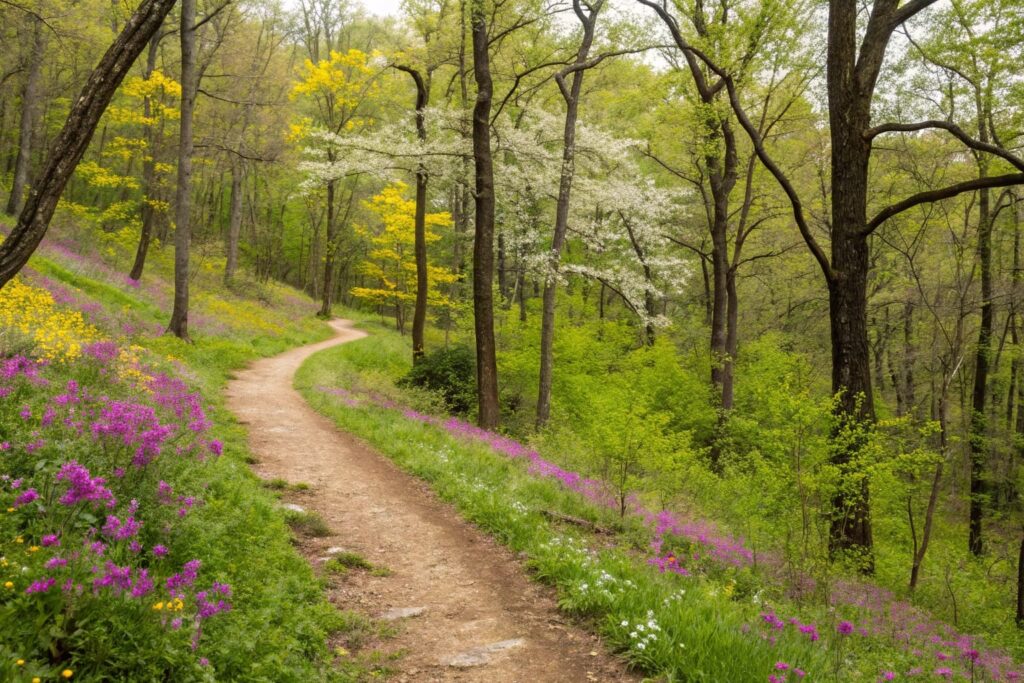The Ouachita Trail stretches 223 miles across Arkansas and Oklahoma. It traverses diverse ecosystems and elevation changes. These factors create distinct seasonal experiences for hikers.
Timing your hike can make the difference between misery and magic. Each season brings unique challenges and rewards. Understanding these patterns helps you plan a successful journey.
“Weather variability on the Ouachita Trail demands careful planning,” notes David Buchanan, co-founder of the Physics AI Solver tool and avid hiker. “I’ve seen temperature swings of 40 degrees in a single day. Mathematical models help predict patterns, but nature always keeps you guessing.”
Spring (March – May): The Wildflower Season

Weather Patterns
Spring temperatures typically range from 50s to 70s Fahrenheit. Rain falls frequently during this season. March averages 5 inches of precipitation.
Weather can shift dramatically. Morning frost may give way to afternoon heat. Severe thunderstorms develop quickly.
Trail Conditions
Recent rains create muddy sections throughout the trail. Creek crossings run high and fast. Early spring vegetation hasn’t been trimmed yet.
Highlights
Spring offers remarkable advantages:
- Peak wildflower displays occur from April through early May
- Temperatures remain comfortable for all-day hiking
- Bug populations haven’t reached summer levels
- Fresh green foliage emerges daily
Challenges
Wet conditions pose significant obstacles. River crossings become dangerous after storms. Lightning threatens exposed ridgelines.
Summer (June – August): The Endurance Test

Weather Patterns
Summer brings intense heat and humidity. Temperatures regularly exceed 90 degrees. Afternoon thunderstorms provide brief relief.
Trail Conditions
Many water sources dry up by July. Vegetation grows thick along narrow sections. Trail maintenance struggles to keep pace.
Highlights
Summer hiking rewards the prepared:
- Daylight extends past 8 PM
- Swimming holes offer refreshing breaks
- Canopy provides maximum shade
- Wildlife activity peaks at dawn and dusk
Challenges
Heat exhaustion threatens unprepared hikers. Mosquitoes and ticks reach peak numbers. Water must be carefully managed between sources.
Fall (September – November): The Golden Season
Weather Patterns
Temperatures moderate to pleasant 60s and 70s. Humidity drops significantly. Weather patterns stabilize.
Trail Conditions
Trails dry out and harden. Fallen leaves begin accumulating by October. Path visibility improves as undergrowth dies back.
Highlights
Fall delivers optimal hiking conditions:
- Spectacular foliage peaks in late October
- Perfect temperatures for sustained hiking
- Bug populations decline sharply
- Clear views emerge through thinning canopy
- Crisp air enhances distant vistas
Challenges
Hunting season requires extra precautions. Popular sections become crowded on weekends. Daylight hours decrease rapidly.
Winter (December – February): The Quiet Season
Weather Patterns
Temperatures fluctuate between 30s and 50s. Ice storms occur periodically. Snow rarely accumulates significantly.
Trail Conditions
Bare trees reveal hidden views. Ice forms on north-facing slopes. Mud freezes and thaws repeatedly.
Highlights
Winter rewards hardy hikers:
- Near-complete solitude on weekdays
- Panoramic views through leafless forest
- No insects whatsoever
- Cool temperatures aid difficult climbs
Challenges
Cold snaps require substantial gear. Daylight barely exceeds 10 hours. Hypothermia risks increase dramatically.
Month-by-Month Quick Reference Guide
| Month | Avg High/Low °F | Rainfall | Key Considerations |
| January | 50/29 | 3.5″ | Ice storms possible |
| February | 55/33 | 3.8″ | Variable conditions |
| March | 64/41 | 5.1″ | Muddy trails |
| April | 73/49 | 4.9″ | Peak wildflowers |
| May | 79/58 | 5.5″ | Increasing heat |
| June | 86/66 | 4.2″ | High humidity |
| July | 91/70 | 3.3″ | Water scarcity |
| August | 91/69 | 2.8″ | Peak heat |
| September | 84/62 | 3.7″ | Ideal temperatures |
| October | 74/50 | 4.1″ | Fall colors |
| November | 62/40 | 4.8″ | Hunting season |
| December | 52/32 | 4.2″ | Cold fronts |
Planning Your Hike: Seasonal Gear Considerations
Spring Essentials
- Quality rain jacket and pack cover
- Gaiters for muddy sections
- Quick-dry clothing layers
- Waterproof boots
Summer Essentials
- 4+ liter water capacity
- Electrolyte supplements
- Broad-spectrum sunscreen
- Permethrin-treated clothing
Fall Essentials
- Versatile layering system
- Blaze orange safety vest
- Headlamp with extra batteries
- Lightweight gloves
Winter Essentials
- 15-degree sleeping bag minimum
- Insulated water bottles
- Microspikes for icy sections
- Emergency bivy
Special Considerations by Trail Section
Eastern sections receive more rainfall year-round. Western portions experience temperature extremes. Higher elevations stay cooler by 5-10 degrees.
Shelter spacing affects seasonal planning. Water availability varies dramatically by section. Local microclimates create surprising variations.
The Verdict: When Should You Go?
Late September through early November offers ideal conditions. Spring wildflower seekers should target mid-April. Solitude hunters find peace in January.
Thru-hikers succeed best in March-April or October-November. Section hikers enjoy maximum flexibility. Weekend warriors should avoid summer heat.
Conclusion
Each season transforms the Ouachita Trail completely. Your perfect timing depends on personal priorities. Weather tolerance varies among individuals.
Research current conditions before departing. Connect with recent hikers for updates. The trail awaits whenever you’re ready.
Remember: there’s no wrong season to hike. Only inadequate preparation makes timing poor. Choose your season and embrace its character.